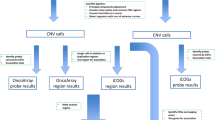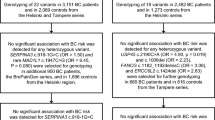Abstract
Several moderate- and high-risk breast cancer susceptibility genes have been discovered, but more are likely to exist. To discover new breast cancer susceptibility genes, we used 2 populations (from Poland and Quebec, Canada) and applied whole-exome sequencing in a discovery phase (n = 195), followed by validation. We identified rare recurrent RECQL mutations in each population. In Quebec, 7 of 1,013 higher-risk breast cancer cases and 1 of 7,136 newborns carried the c.643C>T (p.Arg215*) variant (P = 0.00004). In Poland, 30 of 13,136 unselected breast cancer cases and 2 of 4,702 controls carried the c.1667_1667+3delAGTA (p.K555delinsMYKLIHYSFR) variant (P = 0.008). RECQL is implicated in resolving stalled DNA replication forks to prevent double-stranded DNA (dsDNA) breaks. This function is related to that of other known breast cancer susceptibility genes, many of which are involved in repairing dsDNA breaks. We conclude that RECQL is a breast cancer susceptibility gene.
This is a preview of subscription content, access via your institution
Access options
Subscribe to this journal
Receive 12 print issues and online access
$209.00 per year
only $17.42 per issue
Buy this article
- Purchase on Springer Link
- Instant access to full article PDF
Prices may be subject to local taxes which are calculated during checkout

Similar content being viewed by others
Accession codes
Change history
12 January 2016
In the version of this article initially published, one of the variants was incorrectly reported as c.634C>T. The correct nomenclature for this variant is c.643C>T. The error has been corrected in the HTML and PDF versions of the article.
References
Couch, F.J., Nathanson, K.L. & Offit, K. Two decades after BRCA: setting paradigms in personalized cancer care and prevention. Science 343, 1466–1470 (2014).
Miki, Y. et al. A strong candidate for the breast and ovarian cancer susceptibility gene BRCA1. Science 266, 66–71 (1994).
Wooster, R. et al. Identification of the breast cancer susceptibility gene BRCA2. Nature 378, 789–792 (1995).
Rahman, N. et al. PALB2, which encodes a BRCA2-interacting protein, is a breast cancer susceptibility gene. Nat. Genet. 39, 165–167 (2007).
Bogdanova, N. et al. Nijmegen Breakage Syndrome mutations and risk of breast cancer. Int. J. Cancer 122, 802–806 (2008).
Meijers-Heijboer, H. et al. Low-penetrance susceptibility to breast cancer due to CHEK2(*)1100delC in noncarriers of BRCA1 or BRCA2 mutations. Nat. Genet. 31, 55–59 (2002).
Renwick, A. et al. ATM mutations that cause ataxia-telangiectasia are breast cancer susceptibility alleles. Nat. Genet. 38, 873–875 (2006).
Li, J. et al. PTEN, a putative protein tyrosine phosphatase gene mutated in human brain, breast, and prostate cancer. Science 275, 1943–1947 (1997).
Malkin, D. et al. Germline p53 mutations in a familial syndrome of breast cancer, sarcomas, and other neoplasms. Science 250, 1233–1238 (1990).
Górski, B. et al. Founder mutations in the BRCA1 gene in Polish families with breast-ovarian cancer. Am. J. Hum. Genet. 66, 1963–1968 (2000).
Cybulski, C. et al. A deletion in CHEK2 of 5,395 bp predisposes to breast cancer in Poland. Breast Cancer Res. Treat. 102, 119–122 (2007).
Steffen, J. et al. Germline mutations 657del5 of the NBS1 gene contribute significantly to the incidence of breast cancer in Central Poland. Int. J. Cancer 119, 472–475 (2006).
Tonin, P.N. et al. Founder BRCA1 and BRCA2 mutations in French Canadian breast and ovarian cancer families. Am. J. Hum. Genet. 63, 1341–1351 (1998).
Foulkes, W.D. et al. Identification of a novel truncating PALB2 mutation and analysis of its contribution to early-onset breast cancer in French-Canadian women. Breast Cancer Res. 9, R83 (2007).
Cybulski, C. et al. Mutations predisposing to breast cancer in 12 candidate genes in breast cancer patients from Poland. Clin. Genet. doi:10.1111/cge.12524 (20 October 2014).
Pike, A.C. et al. Structure of the human RECQ1 helicase reveals a putative strand-separation pin. Proc. Natl. Acad. Sci. USA 106, 1039–1044 (2009).
Puranam, K.L. & Blackshear, P.J. Cloning and characterization of RECQL, a potential human homologue of the Escherichia coli DNA helicase RecQ. J. Biol. Chem. 269, 29838–29845 (1994).
Seki, M. et al. Molecular cloning of cDNA encoding human DNA helicase Q1 which has homology to Escherichia coli Rec Q helicase and localization of the gene at chromosome 12p12. Nucleic Acids Res. 22, 4566–4573 (1994).
Sharma, S., Doherty, K.M. & Brosh, R.M. Jr. Mechanisms of RecQ helicases in pathways of DNA metabolism and maintenance of genomic stability. Biochem. J. 398, 319–337 (2006).
Ellis, N.A. et al. The Bloom's syndrome gene product is homologous to RecQ helicases. Cell 83, 655–666 (1995).
Yu, C.E. et al. Positional cloning of the Werner's syndrome gene. Science 272, 258–262 (1996).
Kitao, S. et al. Mutations in RECQL4 cause a subset of cases of Rothmund-Thomson syndrome. Nat. Genet. 22, 82–84 (1999).
Sharma, S. et al. RECQL, a member of the RecQ family of DNA helicases, suppresses chromosomal instability. Mol. Cell. Biol. 27, 1784–1794 (2007).
Sharma, S. & Brosh, R.M. Jr. Human RECQ1 is a DNA damage responsive protein required for genotoxic stress resistance and suppression of sister chromatid exchanges. PLoS ONE 2, e1297 (2007).
Futami, K. et al. Induction of mitotic cell death in cancer cells by small interference RNA suppressing the expression of RecQL1 helicase. Cancer Sci. 99, 71–80 (2008).
Berti, M. et al. Human RECQ1 promotes restart of replication forks reversed by DNA topoisomerase I inhibition. Nat. Struct. Mol. Biol. 20, 347–354 (2013).
Parvathaneni, S., Stortchevoi, A., Sommers, J.A., Brosh, R.M. Jr. & Sharma, S. Human RECQ1 interacts with Ku70/80 and modulates DNA end-joining of double-strand breaks. PLoS ONE 8, e62481 (2013).
Popuri, V. et al. Human RECQL1 participates in telomere maintenance. Nucleic Acids Res. 42, 5671–5688 (2014).
Grepmeier, U. et al. Deletions at chromosome 2q and 12p are early and frequent molecular alterations in bronchial epithelium and NSCLC of long-term smokers. Int. J. Oncol. 27, 481–488 (2005).
Cavallone, L. et al. Comprehensive BRCA1 and BRCA2 mutation analyses and review of French Canadian families with at least three cases of breast cancer. Fam. Cancer 9, 507–517 (2010).
Arcand, S.L. et al. Germline TP53 mutations in BRCA1 and BRCA2 mutation-negative French Canadian breast cancer families. Breast Cancer Res. Treat. 108, 399–408 (2008).
Tischkowitz, M. et al. Contribution of the PALB2 c.2323C>T (p.Q775X) founder mutation in well-defined breast and/or ovarian cancer families and unselected ovarian cancer cases of French Canadian descent. BMC Med. Genet. 14, 5 (2013).
Ghadirian, P. et al. Screening for BRCA1 and BRCA2 mutations among French-Canadian breast cancer cases attending an outpatient clinic in Montreal. Clin. Genet. 85, 31–35 (2014).
Giroux, S. et al. Assessment of the prevalence of the 985A>G MCAD mutation in the French-Canadian population using allele-specific PCR. Clin. Genet. 71, 569–575 (2007).
Li, H. & Durbin, R. Fast and accurate short read alignment with Burrows-Wheeler transform. Bioinformatics 25, 1754–1760 (2009).
McKenna, A. et al. The Genome Analysis Toolkit: a MapReduce framework for analyzing next-generation DNA sequencing data. Genome Res. 20, 1297–1303 (2010).
Acknowledgements
This paper is dedicated to the memory of Parviz Ghadirian. The whole-exome sequencing and part of the Sanger sequencing for these projects were carried out by the McGill University and Génome Québec Innovation Centre. The study was funded in part by the Polish National Science Centre on the basis of decision number DEC-2011/03/N/NZ2/01510 and by the Women's College Research Institute's internal fund. W.D.F. was funded by Susan G. Komen and the Cancer Research Society/Quebec Breast Cancer Foundation. B.R. was funded by Fundación Alfonso Martín Escudero and a fellowship from the Cedars Cancer Institute. J.C.-Z. was funded by the Canadian Institutes of Health Research (CIHR). P.N.T. was funded by the Cancer Research Society, the Quebec Breast Cancer Foundation and the Fonds de Recherche du Québec–Santé. M.R.A. is funded by the Canadian Cancer Society Research Institute and the Canadian Breast Cancer Foundation.
Author information
Authors and Affiliations
Contributions
C.C. contributed to study design, data collection and interpretation of the Polish study and assisted with the drafting of the manuscript. J.C.-Z., J.N. and J.M. contributed to exome data analysis for the French-Canadian study and assisted with the drafting of the manuscript. W.K., A.K., D.W., A.J., H.R., M.L., B.M. and B.G. contributed to data collection for the Polish study. B.R. and N.H. contributed to sample genotyping for the French-Canadian study and assisted with the drafting of the manuscript. S.G. and S.Z. contributed to sample genotyping for the French-Canadian study. T.H., J.G., T.B., M.S. and T.D. contributed to data collection and provided study subjects for the Polish study. P.N.T. and F.R. contributed to data collection and provided study subjects for the French-Canadian study, and they also assisted with the drafting of the manuscript. J.L. contributed to study design and provided study subjects for the Polish study. W.D.F. contributed to study design and data interpretation, provided study subjects for the French-Canadian study and also assisted with the drafting of the manuscript. S.A.N. contributed to study design and data interpretation for both the Polish and French-Canadian studies, provided study subjects for the French-Canadian study and also assisted with the drafting of the manuscript. M.R.A. contributed to study design, analysis of the exome and Sanger sequencing data, and interpretation of the data for both the Polish and French-Canadian studies and also drafted the manuscript.
Corresponding author
Ethics declarations
Competing interests
The authors declare no competing financial interests.
Integrated supplementary information
Supplementary Figure 1 Splicing effect of the RECQL c.1667_1667+3delAGTA mutation.
To investigate the effect of the RECQL c.1667_1667+3delAGTA mutation on the expression of RECQL mRNA, total RNA was extracted from the white blood cells of four mutation carriers and three non-carriers, and cDNA libraries were constructed. A 452-bp sequence from RECQL mRNA was amplified using primers designed to overlap the regions between exons 11 and 12 (forward primer) and exons 14 and 15 (reverse primer). The amplified RECQL mRNA was electrophoresed in a 3% agarose gel. Both carriers of c.1667_1667+3delAGTA mutations (samples 4–7) and non-carriers (samples 1–3) showed the expected 452-bp DNA band, whereas only the mutation carriers (samples 4–7) showed a longer DNA fragment (I, sample 8 is a negative control). Sequencing of PCR products from non-carriers (a) and carriers (b) showed that the extra fragment seen in carriers of c.1667_1667+3delAGTA mutation does not have the deleted single nucleotide (A) at the 3′ end of exon 13; however, it has an insertion of 28 bp from the 5′ end of intron 13 following the three nucleotides (GTA) deleted from this intron, resulting in a net addition of 27 bp to the mRNA spliced from the mutated allele that leads to the loss of a lysine at codon 555 and an insertion of 10 amino acids (MYKLIHYSFR) from codon 555 to 564 of the RECQL protein.
Supplementary Figure 2 Pedigrees of RECQL mutation carriers.
This figure shows the pedigrees of nine RECQL c.1667_1667+3delAGTA mutation carriers who have a positive family history for breast cancer and who were identified from 13,611 women with breast cancer not selected for a family history of cancer. The type of cancer and age at diagnosis are indicated next to the symbol. A plus sign (+) indicates mutation carriers. PSU, primary cancer site unknown.
Supplementary information
Supplementary Text and Figures
Supplementary Figures 1 and 2, and Supplementary Tables 1–4. (PDF 1233 kb)
Rights and permissions
About this article
Cite this article
Cybulski, C., Carrot-Zhang, J., Kluźniak, W. et al. Germline RECQL mutations are associated with breast cancer susceptibility. Nat Genet 47, 643–646 (2015). https://doi.org/10.1038/ng.3284
Received:
Accepted:
Published:
Issue Date:
DOI: https://doi.org/10.1038/ng.3284
This article is cited by
-
The Impact of microRNA SNPs on Breast Cancer: Potential Biomarkers for Disease Detection
Molecular Biotechnology (2024)
-
Leveraging the replication stress response to optimize cancer therapy
Nature Reviews Cancer (2023)
-
Cancer Predisposition Genes in Adolescents and Young Adults (AYAs): a Review Paper from the Italian AYA Working Group
Current Oncology Reports (2022)
-
Diagnostic yield and clinical relevance of expanded genetic testing for cancer patients
Genome Medicine (2022)
-
Genetic predisposition to male breast cancer in Poland
BMC Cancer (2021)



